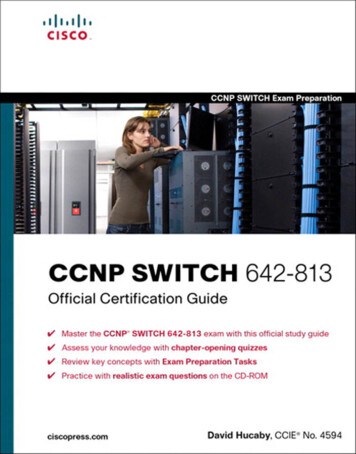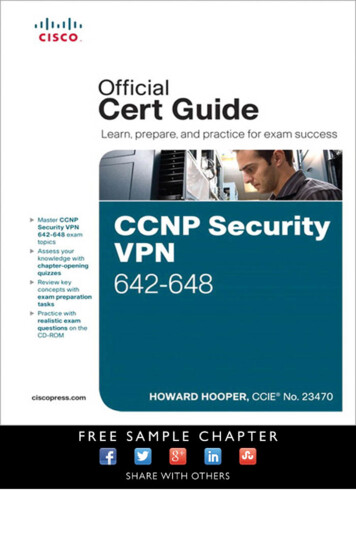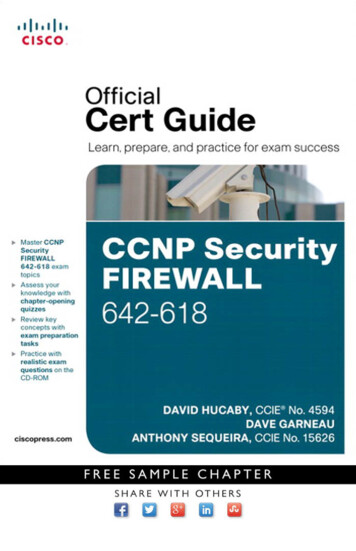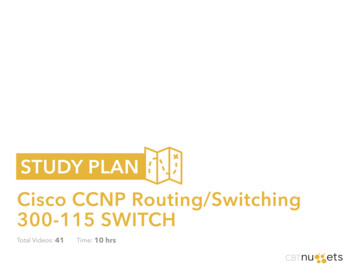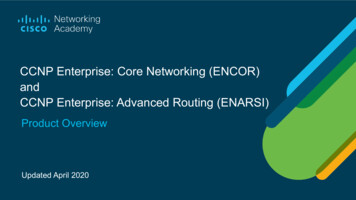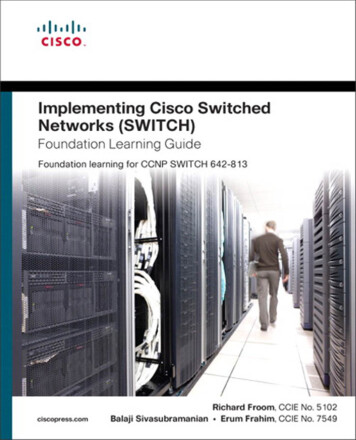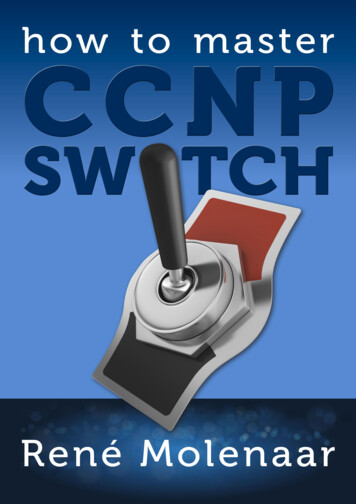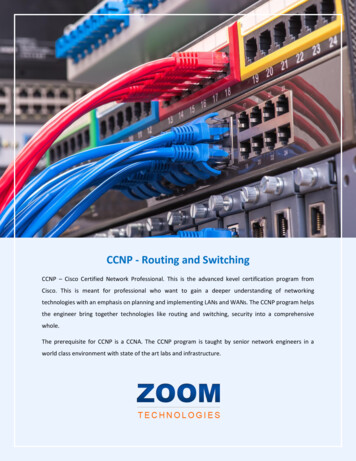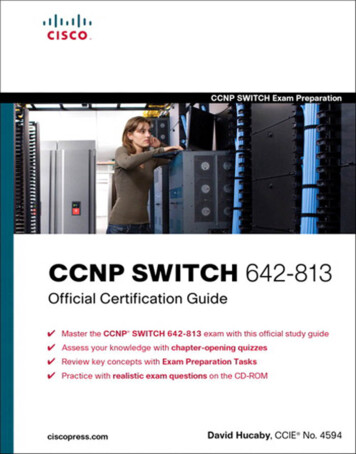
Transcription
iiCCNP SWITCH 642-813 Official Certification GuideCCNP SWITCH 642-813 Official Certification GuideDavid Hucaby, CCIE No. 4594Copyright 2010 Pearson Education, Inc.Published byCisco Press800 East 96th StreetIndianapolis, IN 46240 USAAll rights reserved. No part of this book may be reproduced or transmitted in any form or by any means,electronic or mechanical, including photocopying, recording, or by any information storage and retrievalsystem, without written permission from the publisher, except for the inclusion of brief quotations in areview.Printed in the United States of AmericaFirst Printing February 2010Library of Congress Cataloging-in-Publication Data:Hucaby, Dave.CCNP SWITCH 642-813 official certification guide / David Hucaby.p. cm.ISBN-13: 978-1-58720-243-8ISBN-10: 1-58720-243-31. Virtual LANs—Examinations—Study guides. 2. Telecommunications engineers—Certification.3. Cisco Systems, Inc.—Examinations—Study guides. I. Title.TK5103.8.H8327 2010004.6076—dc222009050384Warning and DisclaimerThis book is designed to provide information about the CCNP SWITCH Exam (Exam 642-813) for theCCNP Routing and Switching certification. Every effort has been made to make this book as completeand as accurate as possible, but no warranty or fitness is implied.The information is provided on an “as is” basis. The authors, Cisco Press, and Cisco Systems, Inc. shall haveneither liability nor responsibility to any person or entity with respect to any loss or damages arising fromthe information contained in this book or from the use of the discs or programs that may accompany it.The opinions expressed in this book belong to the author and are not necessarily those of Cisco Systems, Inc.Trademark AcknowledgmentsAll terms mentioned in this book that are known to be trademarks or service marks have been appropriately capitalized. Cisco Press or Cisco Systems, Inc., cannot attest to the accuracy of this information. Use ofa term in this book should not be regarded as affecting the validity of any trademark or service mark.
xxCCNP SWITCH 642-813 Official Certification GuideForewordCCNP SWITCH 642-813 Official Certification Guide is an excellent self-studyresource for the CCNP SWITCH exam. Passing this exam is a crucial step to attaining thevalued CCNP Routing and Switching certification.Gaining certification in Cisco technology is key to the continuing educational development of today’s networking professional. Through certification programs, Cisco validatesthe skills and expertise required to effectively manage the modern enterprise network.Cisco Press Certification Guides and preparation materials offer exceptional—andflexible—access to the knowledge and information required to stay current in your fieldof expertise or to gain new skills. Whether used as a supplement to more traditionaltraining or as a primary source of learning, these materials offer users the informationand knowledge validation required to gain new understanding and proficiencies.Developed in conjunction with the Cisco certifications and training team, Cisco Pressbooks are the only self-study books authorized by Cisco and offer students a series ofexam practice tools and resource materials to help ensure that learners fully grasp theconcepts and information presented.Additional authorized Cisco instructor-led courses, e-learning, labs, and simulations areavailable exclusively from Cisco Learning Solutions Partners worldwide. To learn more,visit http://www.cisco.com/go/training.I hope that you find these materials to be an enriching and useful part of your exampreparation.Erik UllandersonManager, Global CertificationsLearning@CiscoJanuary 2010
xxiIntroduction: Overview of Certification and How toSucceedProfessional certifications have been an important part of the computing industry formany years and will continue to become more important. Many reasons exist for thesecertifications, but the most popularly cited reason is that of credibility. All other considerations held equal, the certified employee/consultant/job candidate is considered morevaluable than one who is not.Objectives and MethodsThe most important and somewhat obvious objective of this book is to help you pass theCisco CCNP SWITCH exam (Exam 642-813). In fact, if the primary objective of thisbook were different, the book’s title would be misleading; however, the methods used inthis book to help you pass the SWITCH exam are designed to also make you much moreknowledgeable about how to do your job. Although this book and the accompanying CDhave many exam preparation tasks and example test questions, the method in which theyare used is not to simply make you memorize as many questions and answers as youpossibly can.The methodology of this book helps you discover the exam topics about which you needmore review, fully understand and remember exam topic details, and prove to yourselfthat you have retained your knowledge of those topics. So this book helps you pass notby memorization, but by helping you truly learn and understand the topics. The SWITCHexam is just one of the foundation topics in the CCNP Routing and Switching certification, and the knowledge contained within is vitally important to consider yourself a trulyskilled routing and switching engineer or specialist. This book would do you a disserviceif it did not attempt to help you learn the material. To that end, the book can help youpass the SWITCH exam by using the following methods: Covering all the exam topics and helping you discover which exam topics you havenot mastered Providing explanations and information to fill in your knowledge gaps Supplying exam preparation tasks and example networks with diagrams and sampleconfigurations that all enhance your ability to recall and deduce the answers to testquestions Providing practice exercises on the exam topics and the testing process through testquestions on the CD
xxiiCCNP SWITCH 642-813 Official Certification GuideWho Should Read This Book?This book is not designed to be a general networking topics book, although it can beused for that purpose. This book is intended to tremendously increase your chances ofpassing the Cisco SWITCH exam. Although other objectives can be achieved from usingthis book, the book is written with one goal in mind: to help you pass the exam.The SWITCH exam is primarily based on the content of the Cisco SWITCH course. Youshould have either taken the course, read through the SWITCH coursebook or this book,or have a couple of years of LAN switching experience.Cisco Certifications and ExamsCisco offers four levels of routing and switching certification, each with an increasinglevel of proficiency: Entry, Associate, Professional, and Expert. These are commonlyknown by their acronyms CCENT (Cisco Certified Entry Networking Technician), CCNA(Cisco Certified Network Associate), CCNP (Cisco Certified Network Professional), andCCIE (Cisco Certified Internetworking Expert). There are others, too, but this bookfocuses on the certifications for enterprise networks.For the CCNP Routing and Switching certification, you must pass exams on a series ofCCNP topics, including the SWITCH, ROUTE, and TSHOOT exams. For most exams,Cisco does not publish the scores needed for passing. You need to take the exam to findthat out for yourself.To see the most current requirements for the CCNP Routing and Switching certification,go to Cisco.com and click Training and Events. There you can find out other exam detailssuch as exam topics and how to register for an exam.The strategy you use to prepare for the SWITCH exam might be slightly different fromstrategies used by other readers, mainly based on the skills, knowledge, and experienceyou already have obtained. For instance, if you have attended the SWITCH course, youmight take a different approach than someone who learned switching through on-the-jobtraining. Regardless of the strategy you use or the background you have, this book isdesigned to help you get to the point where you can pass the exam with the least amountof time required.How This Book Is OrganizedAlthough this book can be read cover to cover, it is designed to be fiexible and allow youto easily move between chapters and sections of chapters to cover only the material thatyou need more work with. The chapters can be covered in any order, although somechapters are related and build upon each other. If you do intend to read them all, theorder in the book is an excellent sequence to use.Each core chapter covers a subset of the topics on the CCNP SWITCH exam. The chapters are organized into parts, covering the following topics:
xxiiiPart I: New CCNP Exam Approaches Chapter 1, “The Planning Tasks of the CCNP Exams”—This chapter explains theroles of a networking professional in the context of the Cisco Lifecycle Model,where network tasks form a cycle over time. The CCNP SWITCH exam covers realworld or practical skills that are necessary as a network is designed, planned, implemented, verified, and tuned.Part II: Building a Campus Network Chapter 2, “Switch Operation”—This chapter covers Layer 2 and multilayer switchoperation, how various content-addressable memory (CAM) and ternary contentaddressable memory (TCAM) tables are used to make switching decisions, and howto monitor these tables to aid in troubleshooting. Chapter 3, “Switch Port Configuration”—This chapter covers basic Ethernet concepts, how to use scalable Ethernet, how to connect switch and devices together, andhow to verify switch port operation to aid in troubleshooting. Chapter 4, “VLANs and Trunks”—This chapter covers basic VLAN concepts, howto transport multiple VLANs over single links, how to configure VLAN trunks, andhow to verify VLAN and trunk operation. Chapter 5, “VLAN Trunking Protocol”—This chapter covers VLAN managementusing VTP, VTP configuration, traffic management through VTP pruning, and howto verify VTP operation. Chapter 6, “Aggregating Switch Links”—This chapter covers switch port aggregation with EtherChannel, EtherChannel negotiation protocols, EtherChannel configuration, and how to verify EtherChannel operation. Chapter 7, “Traditional Spanning Tree Protocol”—This chapter covers IEEE 802.1DSpanning Tree Protocol (STP) and gives an overview of the other STP types thatmight be running on a switch. Chapter 8, “Spanning-Tree Configuration”—This chapter covers the STP rootbridge, how to customize the STP topology, how to tune STP convergence, redundant link convergence, and how to verify STP operation. Chapter 9, “Protecting the Spanning Tree Protocol Topology”—This chaptercovers protecting the STP topology using Root Guard, BPDU Guard, and LoopGuard, and also how to use BPDU filtering and how to verify that these STP protection mechanisms are functioning properly. Chapter 10, “Advanced Spanning Tree Protocol”—This chapter covers RapidSpanning Tree Protocol (RSTP) for Rapid PVST and Multiple Spanning Tree (MST)Protocol. Chapter 11, “Multilayer Switching”—This chapter covers interVLAN routing,multilayer switching with Cisco Express Forwarding (CEF), and how to verify thatmultilayer switching is functioning properly.
xxivCCNP SWITCH 642-813 Official Certification GuidePart III: Designing Campus Networks Chapter 12, “Enterprise Campus Network Design”—This chapter covers differentcampus network models, hierarchical network design, and how to design, size, andscale a campus network using a modular approach. Chapter 13, “Layer 3 High Availability”—This chapter covers providing redundantrouter or gateway addresses on Catalyst switches and verifying that redundancy isfunctioning properly.Part IV: Campus Network Services Chapter 14, “IP Telephony”—This chapter covers how a Catalyst switch can provide power to operate a Cisco IP Phone, how voice traffic can be carried over thelinks between an IP Phone and a Catalyst switch, QoS for voice traffic, and how toverify that IP Telephony features are functioning properly. Chapter 15, “Integrating Wireless LANs”—This chapter covers different approaches to integrating autonomous and lightweight wireless access points into a switchedcampus network.Part V: Securing Switched Networks Chapter 16, “Securing Switch Access”—This chapter covers switch authentication,authorization, and accounting (AAA); port security using MAC addresses; portbased security using IEEE 802.1x; DHCP snooping; and dynamic ARP inspection. Chapter 17, “Securing with VLANs”—This chapter covers how to control trafficwithin a VLAN using access lists, implementing private VLANs, and monitoring traffic on switch ports for security reasons.Part VI: Final Exam Preparation Chapter 18, “Final Preparation”—This chapter explains how to use the practiceexam CD to enhance your study, along with a basic study plan.There is also an appendix that has answers to the “Do I Know This Already” quizzes andan appendix that tells you how to find any updates should there be changes to the exam.Each chapter in the book uses several features to help you make the best use of yourtime in that chapter. The features are as follows: Assessment—Each chapter begins with a “Do I Know This Already?” quiz thathelps you determine the amount of time you need to spend studying each topic ofthe chapter. If you intend to read the entire chapter, you can save the quiz for lateruse. Questions are all multiple choice, to give a quick assessment of your knowledge. Foundation Topics—This is the core section of each chapter that explains the protocols, concepts, and configuration for the topics in the chapter. Exam Preparation Tasks—At the end of each chapter, this section collects key topics, references to memory table exercises to be completed as memorization practice,key terms to define, and a command reference that summarizes relevant commandspresented in the chapter.
xxvFinally, there is a CD-based practice exam. The companion CD contains a practice CCNPSWITCH exam containing a bank of test questions to reinforce your understanding of thebook’s concepts. This is the best tool for helping you prepare for the actual test-takingprocess.The CD also contains the Memory Table exercises and answer keys that come up at theend of each chapter.How to Use This Book for StudyRetention and recall are the two features of human memory most closely related to performance on tests. This exam-preparation guide focuses on increasing both retention andrecall of the topics on the exam. The other human characteristic involved in successfullypassing the exam is intelligence; this book does not address that issue!This book is designed with features to help you increase retention and recall. It does thisin the following ways: By providing succinct and complete methods of helping you decide what you recalleasily and what you do not recall at all. By giving references to the exact passages in the book that review those conceptsyou most need to recall, so you can quickly be reminded about a fact or concept.Repeating information that connects to another concept helps retention, and describing the same concept in several ways throughout a chapter increases the number ofconnectors to the same pieces of information. Finally, accompanying this book is a CD that has exam-like questions. These are useful for you to practice taking the exam and to get accustomed to the time restrictions imposed during the exam.When taking the “Do I Know This Already?” assessment quizzes in each chapter, makesure that you treat yourself and your knowledge fairly. If you come across a question thatmakes you guess at an answer, mark it wrong immediately. This forces you to readthrough the part of the chapter that relates to that question and forces you to learn itmore thoroughly.If you find that you do well on the assessment quizzes, it still might be wise to quicklyskim through each chapter to find sections or topics that do not readily come to mind.Look for the Key Topics icons. Sometimes even reading through the detailed table of contents will reveal topics that are unfamiliar or unclear. If that happens to you, mark thosechapters or topics and spend time working through those parts of the book.CCNP SWITCH Exam TopicsCarefully consider the exam topics Cisco has posted on its website as you study, particularly for clues to how deeply you should know each topic. Beyond that, you cannot gowrong by developing a broader knowledge of the subject matter. You can do that byreading and studying the topics presented in this book. Remember that it is in your bestKeyTopic
xxviCCNP SWITCH 642-813 Official Certification Guideinterest to become proficient in each of the CCNP subjects. When it is time to use whatyou have learned, being well rounded counts more than being well tested.Table I-1 shows the official exam topics for the SWITCH exam, as posted on Cisco.com.Note that Cisco has occasionally changed exam topics without changing the exam number, so do not be alarmed if small changes in the exam topics occur over time. When indoubt, go to Cisco.com and click Training and Events.Table I-1—CCNP SWITCH Exam TopicsExam TopicPart of This BookWhere Exam TopicIs CoveredImplement VLAN-based solution, given a network design and a set of requirementsDetermine network resources needed for implementingVLAN-based solution on a network.Create a VLAN-based implementation plan.Create a VLAN-based verification plan.Configure switch-to-switch connectivity for the VLAN-based solution.Configure loop prevention for the VLAN-based solution.Configure access ports for the VLAN-based solution.Verify the VLAN-based solution was implemented properlyusing show and debug commands.Document results of VLAN implementation and verificationPart II, “Building aCampus Network”Chapters 2–10Implement a security extension of a Layer 2 solution, given a network design and a setof requirementsDetermine network resources needed forimplementing a security solution.Create a implementation plan for the security solution.Create a verification plan for the security solution.Configure port security features.Configure general switch security features.Configure private VLANs.Configure VACL and PACL.Verify the security solution was implemented properlyusing show and debug commands.Document results of security implementation and verification.Part V, “SecuringSwitched Networks”Chapters 16–17
xxviiTable I-1—CCNP SWITCH Exam TopicsExam TopicPart of This BookWhere Exam TopicIs CoveredImplement switch-based Layer 3 services, given a network design and a set ofrequirementsDetermine network resources needed forPart II, “Building aimplementing a switch-based Layer 3 solution.Campus Network”Create an implementation plan for the switch-based Layer 3 solution.Chapter 11Create a verification plan for the switch-based Layer 3 solution.Configure routing interfaces.Configure Layer 3 security.Verify the switch-based Layer 3 solution was implementedproperly using show and debug commands.Document results of switch-based Layer 3 implementation and verification.Prepare infrastructure to support advanced servicesImplement a wireless extension of a Layer 2 solution.Implement a VoIP support solution.Implement video support solution.Part IV, “CampusNetwork Services”Chapters 14–15Implement high availability, given a network design and a set of requirementsDetermine network resources needed for implementinghigh availability on a network.Create a high availability implementation plan.Create a high availability verification plan.Implement first-hop redundancy protocols.Implement switch supervisor redundancy.Verify high-availability solution was implemented properlyusing show and debug commands.Document results of high-availability implementation and verification.Part III, “DesigningCampus Networks”Chapters 12–13For More InformationIf you have any comments about the book, you can submit those via the Ciscopress.comwebsite. Just go to the website, select Contact Us, and type in your message. Cisco mightmake changes that affect the CCNP Routing and Switching certification from time totime. You should always check Cisco.com for the latest details. Also, you can look tohttp://www.ciscopress.com/title/ 1587202433, where we publish any information pertinent to how you might use this book differently in light of future changes from Cisco.For example, if Cisco decides to remove a major topic from the exam, it might post thaton its website; Cisco Press will make an effort to list that information as well via anonline updates appendix.
This chapter covers the following topics that you need to master for the CCNP SWITCH exam:Protecting Against Unexpected BPDUs—This sectioncovers the Root Guard and BPDU Guard features, which protect against unexpected root candidates and unexpected BPDUs, respectively.Protecting Against Sudden Loss of BPDUs—This sectiondiscusses the Loop Guard and UDLD features, which detectand protect against the loss of root bridge BPDUs and conditions causing unidirectional links, respectively.Using BPDU Filtering to Disable STP on a Port—This section explains how to filter BPDUs on a switch port to preventthe port from participating in STP altogether. Bridging loopsare neither detected nor prevented.Troubleshooting STP Protection—This section summarizes the commands that diagnose or verify actions to protectthe topology.
CHAPTER 9Protecting the Spanning TreeProtocol TopologyAchieving and maintaining a loop-free Spanning Tree Protocol (STP) topology revolvesaround the simple process of sending and receiving bridge protocol data units (BPDU).Under normal conditions, with all switches playing fairly and according to the rules, aloop-free topology is determined dynamically.This chapter discusses two basic conditions that can occur to disrupt the loop-free topology (even while STP is running):On a port that has not been receiving BPDUs, BPDUs are not expected. When BPDUs suddenly appear for some reason, the STP topology can reconverge to give unexpected results.On a port that normally receives BPDUs, BPDUs always are expected. When BPDUs suddenly disappear for some reason, a switch can make incorrect assumptions about thetopology and unintentionally create loops.“Do I Know This Already?” QuizThe “Do I Know This Already?” quiz allows you to assess whether you should read thisentire chapter thoroughly or jump to the “Exam Preparation Tasks” section. If you are indoubt based on your answers to these questions or your own assessment of your knowledge of the topics, read the entire chapter. Table 9-1 outlines the major headings in thischapter and the “Do I Know This Already?” quiz questions that go with them. You canfind the answers in Appendix A, “Answers to the ‘Do I Know This Already?’ Quizzes.”Table 9-1 “Do I Know This Already?” Foundation Topics Section-to-QuestionMappingFoundation Topics SectionQuestions Covered in This SectionProtecting Against Unexpected BPDUs1–5Protecting Against Sudden Loss of BPDUs6–11Using BPDU Filtering to Disable STP on a Port12Troubleshooting STP Protection131. Why is it important to protect the placement of the root bridge?a.To keep two root bridges from becoming activeb.To keep the STP topology stable
178CCNP SWITCH 642-813 Official Certification Guidec.So all hosts have the correct gatewayd.So the root bridge can have complete knowledge of the STP topology2. Which of the following features protects a switch port from accepting superior BPDUs?a.STP Loop Guardb.STP BPDU Guardc.STP Root Guardd.UDLD3. Which of the following commands can you use to enable STP Root Guard on aswitch port?a.spanning-tree root guardb.spanning-tree root-guardc.spanning-tree guard rootd.spanning-tree rootguard enable4. Where should the STP Root Guard feature be enabled on a switch?a.All portsb.Only ports where the root bridge should never appearc.Only ports where the root bridge should be locatedd.Only ports with PortFast enabled5. Which of the following features protects a switch port from accepting BPDUs whenPortFast is enabled?a.STP Loop Guardb.STP BPDU Guardc.STP Root Guardd.UDLD6. To maintain a loop-free STP topology, which one of the following should a switch uplink be protected against?a.A sudden loss of BPDUsb.Too many BPDUsc.The wrong version of BPDUsd.BPDUs relayed from the root bridge7. Which of the following commands can enable STP Loop Guard on a switch port?a.spanning-tree loop guardb.spanning-tree guard loopc.spanning-tree loop-guardd.spanning-tree loopguard enable
Chapter 9: Protecting the Spanning Tree Protocol Topology8. STP Loop Guard detects which of the following conditions?a.The sudden appearance of superior BPDUsb.The sudden lack of BPDUsc.The appearance of duplicate BPDUsd.The appearance of two root bridges9. Which of the following features can actively test for the loss of the receive side of alink between switches?a.POSTb.BPDUc.UDLDd.STP10. UDLD must detect a unidirectional link before which of the following?a.The Max Age timer expires.b.STP moves the link to the Blocking state.c.STP moves the link to the Forwarding state.d.STP moves the link to the Listening state.11. What must a switch do when it receives a UDLD message on a link?a.Relay the message on to other switchesb.Send a UDLD acknowledgmentc.Echo the message back across the linkd.Drop the message12. Which of the following features effectively disables spanning-tree operation on aswitch port?a.STP PortFastb.STP BPDU filteringc.STP BPDU Guardd.STP Root Guard13. To reset switch ports that have been put into the errdisable mode by UDLD, whichone of the following commands should be used?a.clear errdisable udldb.udld resetc.no udldd.show udld errdisable179
180CCNP SWITCH 642-813 Official Certification GuideFoundation TopicsProtecting Against Unexpected BPDUsA network running STP uses BPDUs to communicate between switches (bridges).Switches become aware of each other and of the topology that interconnects them. Aftera root bridge is elected, BPDUs are generated by the root and are relayed down throughthe spanning-tree topology. Eventually, all switches in the STP domain receive the root’sBPDUs so that the network converges and a stable loop-free topology forms.To maintain an efficient topology, the placement of the root bridge must be predictable.Hopefully, you configured one switch to become the root bridge and a second one to bethe secondary root. What happens when a “foreign” or rogue switch is connected to thenetwork, and that switch suddenly is capable of becoming the root bridge? Cisco addedtwo STP features that help prevent the unexpected: Root Guard and BPDU Guard.Root GuardAfter an STP topology has converged and becomes loop free, switch ports are assignedthe following roles: Root port—The one port on a switch that is closest (with the lowest root path cost)to the root bridge. Designated port—The port on a LAN segment that is closest to the root. This portrelays, or transmits, BPDUs down the tree. Blocking port—Ports that are neither root nor designated ports. Alternate port—Ports that are candidate root ports (they are also close to the rootbridge) but are in the Blocking state. These ports are identified for quick use by theSTP UplinkFast feature. Forwarding port—Ports where no other STP activity is detected or expected. Theseare ports with normal end-user connections.The root bridge always is expected to be seen on the root port and the alternative portsbecause these are “closest” (have the best-cost path) to it.Suppose that another switch is introduced into the network with a bridge priority that ismore desirable (lower) than that of the current root bridge. The new switch then would become the root bridge, and the STP topology might reconverge to a new shape. This is entirely permissible by the STP because the switch with the lowest bridge ID always winsthe root election.However, this is not always desirable for you, the network administrator, because the newSTP topology might be something totally unacceptable. In addition, while the topology isreconverging, your production network might become unavailable.KeyTopicThe Root Guard feature was developed as a means to control where candidate root bridgescan be connected and found on a network. Basically, a switch learns the current root
Chapter 9: Protecting the Spanning Tree Protocol Topology181bridge’s bridge ID. If another switch advertises a superior BPDU, or one with a betterbridge ID, on a port where Root Guard is enabled, the local switch will not allow the newswitch to become the root. As long as the superior BPDUs are being received on the port,the port will be kept in the root-inconsistent STP state. No data can be sent or received inthat state, but the switch can listen to BPDUs received on the port to detect a new root advertising itself.In essence, Root Guard designates that a port can only forward or relay BPDUs; the portcan’t be used to receive BPDUs. Root Guard prevents the port from ever becoming a rootport where BPDUs normally would be received from the root bridge.You can enable Root Guard only on a per-port basis. By default, it is disabled on all switchports. To enable it, use the following interface configuration command:Switch(config-if)# spanning-tree guard rootWhen the superior BPDUs no longer are received, the port is cycled through the normalSTP states to return to normal use.Use Root Guard on switch ports where you never expect to find the root bridge for aVLAN. In fact, Root Guard affects the entire port so that a root bridge never can be allowed on any VLAN on the port. When a superior BPDU is heard on the port, the entireport, in effect, becomes blocked.Tip: You can display switch ports that Root Guard has put into the root-inconsistent statewith the following command:Switch# show spanning-tree inconsistentportsBPDU GuardRecall that the traditional STP offers the PortFast feature, in which switch ports are allowed to immediately enter the Forwarding state as soon as the link comes up. Normally,PortFast provides quick network access to end-user de
CCNP SWITCH 642-813 Official Certification Guideis an excellent self-study resource for the CCNP SWITCH exam. Passing this exam is a crucial step to attaining the valued CCNP Routing and Switching certification. Gaining certification in Cisco technology is key to the continuing edu
